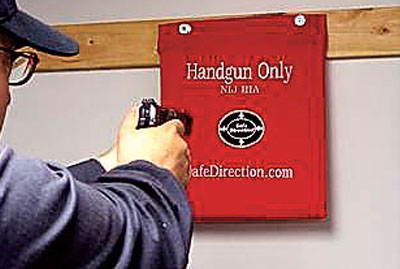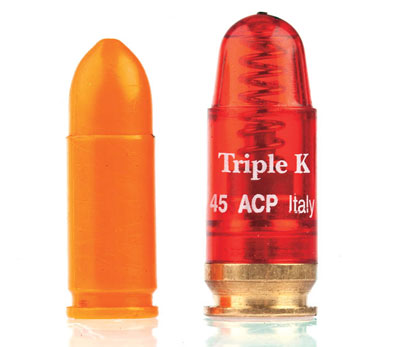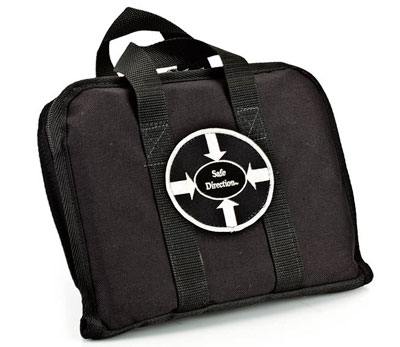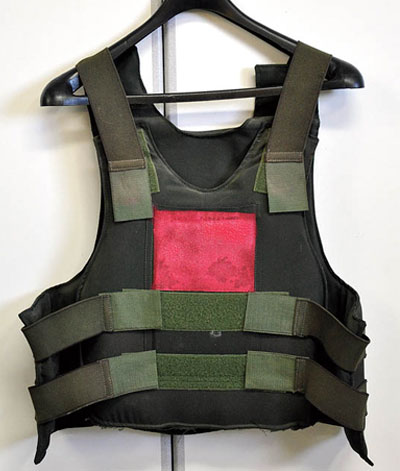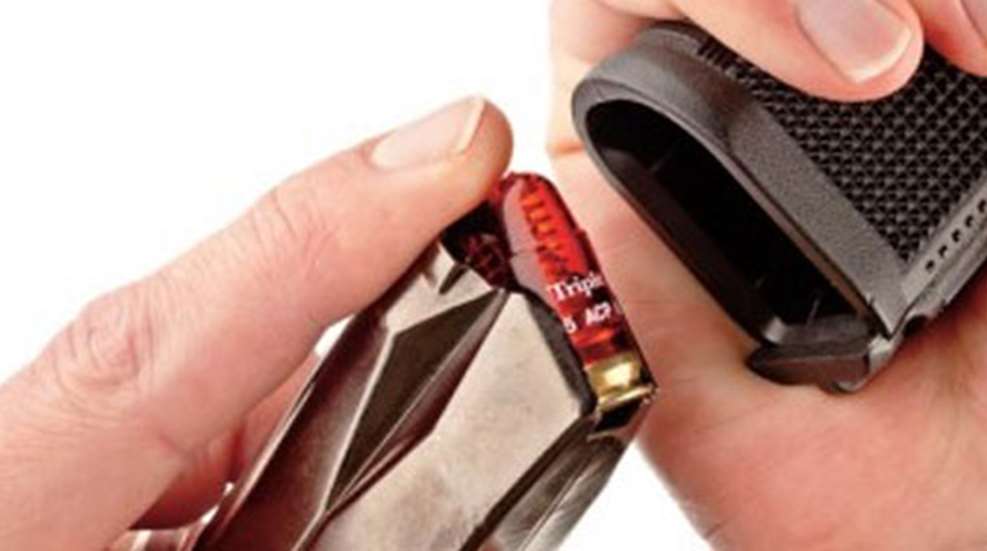
Duffytown. Not far from San Diego, this tiny burg doesn't appear on any maps. Tourists don't go there, only cops, because it is a very dangerous place to be if you aren't paying attention. When I received the call to "see the man" at the only hotel in town, I suspected trouble. As I carefully entered through the front door, my suspicions were confirmed, because no one was in sight.
Approaching the hotel desk, I noted a doorway and a small room behind the counter. An open stairway to my right. "Border Patrol, anyone there?" I said. At that moment, I heard footsteps on the stairway and saw an armed man coming down the stairs while raising a pistol toward me. With no time to turn and face the threat or get two hands on my own pistol, I drew with one hand and fired."Exercise over," said the deputy who stepped out from the room behind the hotel desk. "Holster your weapon...let's talk."
This scene played out some years ago while I was attending an Advanced Officer's Training course put on by the San Diego County Sheriff's Office at its training facility outside of San Diego. Duffytown, named after a former sheriff, was a large training simulator set up to look like a city street and lined with various buildings, including the aforementioned hotel. During my debrief, the two training officers commented I was the first officer to have made it through this particular scenario, as, invariably, one or the other of them was able to "shoot" the officer before he or she could react. They attributed my success to my quick, one-handed draw and asked how I had managed it. "I practice," I said.
Apparently this was not the right thing to say, because it resulted in a lecture and a stern warning concerning the dangers of quick-draw practice. I suppose I was to conclude not practicing and getting shot was preferable to the potential dangers encountered in regular training and practice.
Fortunately, attitudes have changed, training has advanced in the ensuing years and we have learned one of the keys to both speed and accuracy is practice—lots of it. What's more, we have learned dry-fire practice can be just as valuable as live-fire training on the range, perhaps even more so. So what should be our goal and how do we do it safely?
Reflexive Training
According to Mr. Webster, reflex actions are those actions of the nervous system that are performed involuntarily and often unconsciously. In firearms training, we refer to reflexive actions as those we have learned through repetition to perform without conscious thought. In order for an act to become reflexive, we need to repeat it many times—perhaps as many as 5,000—and just as important, we need to do it correctly.
As to how reflexive skills work, remember back to when you first learned to drive. Pretty clumsy, wasn't it? After time and with practice, your skills began to smooth out. Now, after driving for many years, you can perform the actions required without consciously thinking about performing them—your driving skills have become reflexive.
We start off slowly, breaking the action down into steps, then smooth it out. Speed comes with continued practice. Most of us don't have the time or ammunition to do all of our shooting practice on the firing range, so dry-fire practice is the easiest and most economic solution. A realistic goal in learning a new shooting skill might be to spend 80 to 90 percent of your practice time doing it dry—and of course correctly—with occasional trips to the range to reinforce your training with live fire. All of us can benefit from dry-firing, whether learning new skills or reinforcing old ones, and as little as two or three 10-minute practice sessions a week are all you may need to maintain and improve your skills.
The quick draw I pulled off during the training scenario came as a result of many years of practice. When I joined the Border Patrol, I was determined to bring my shooting skills to the highest possible level. I was fortunate to have been trained by some real-deal firearm experts. For many years, I made a habit of practicing my draw every day before going to work. I would put on my uniform and, after carefully unloading and checking my pistol, I'd practice handgun presentations until I started to break into a sweat—a matter of 5 to 10 minutes, depending upon the temperature.
Once finished, I loaded the pistol, placed it in the holster and told myself, "Time to go to work." That practice and repetition served me well and probably saved my butt more times than I can remember throughout my career.
Do It Safely
I really can't criticize the training officers who took me to task for practicing my quick-draw technique, since that was the prevailing training doctrine of the time. Many tragedies have occurred during what was supposed to be dry-fire practice, and too many negligent discharges and self-inflicted gunshots have resulted from poor training or the desire to advance too quickly.
In order to practice dry-firing safely, the first step must be getting into the right state of mind. Don't practice when you have something else on your mind or when you feel rushed. Only begin a training session after consciously telling yourself you are going to perform dry-fire practice and nothing else. It helps if you have a single place in your home to practice, one you have set up and designated as your dry-fire practice area. In my home that area is in the garage. Yours may be someplace else, but it should be an area where you are unlikely to be interrupted or distracted.
Next, you need a safe backstop, something capable of stopping a bullet. This should be your dry-fire practice target, and the only thing in your home at which you ever point a gun when pressing the trigger. For example, there are a number of pistols requiring the trigger to be pulled in order to unlock the action for disassembly. If you have such a pistol, get it into your head you will never, ever, press that trigger for disassembly unless the gun is pointed at your dry-fire practice target.
My practice target consists of police body armor with two extra panels stuffed into the carrier pockets and also includes a steel trauma plate. The trauma plate pocket is painted red, and that's my aiming point. Another good idea is the Safe Direction composite armor-board practice target, which is issued to students at Gunsite. Made to contain a handgun bullet, these are excellent dry-fire practice targets and can be set up easily almost anywhere.
The next step in safe dry-fire practice is to eliminate any live ammunition from your practice area. Unload the pistol, physically and visually verify it is unloaded, check it again and only then begin the practice session. Using dummy training rounds is another good idea. These are often colored orange or red, and provide a quick visual cue they are not live ammunition. Dummy rounds also allow you to practice various functions, such as loading and unloading, along with chamber checks.
I have even set up a dummy pistol. This is a Colt 1911 I shot for many years but have now retired to practice status. The firing pin is cut off so it cannot possibly fire, the muzzle is plugged, there is a slot cut in the barrel hood and its grips are painted red. I use this pistol along with two magazines with red base plates that only contain dummy rounds to perform demonstrations during training and for dry-fire practice.
Focus Your Training
Once you're in the right mindset, have set up your dry-fire practice target and ensured your firearm is unloaded, you can start practicing. It's probably a good idea to focus on just one or two skills per session. If you really concentrate and put some effort into it, 10 minutes per session is plenty.
Think about the skill you are developing and talk yourself through the steps while trying to perform each one as correctly as possible. Don't concern yourself with speed, especially at first. Speed will come as you hone your skills and eliminate unnecessary motions.
If practicing your draw stroke, for example, think about the four or five steps involved, the elements of each step and visualize and vocalize as you slowly perform them correctly. If it helps you to visualize responding to a threat—perhaps an armed robber—go ahead and do so. Visualization and playing the "what am I going to do if..." game can be an important part of your training. If you are pleased with having done everything correctly, do it again, perhaps picking up the speed, but continuing to talk yourself through the steps. Continue in this manner until you are performing the skill smoothly and correctly.
What skills you work on during dry-fire practice is up to you. Examples of some of the handgun skills you can practice with dry fire include: draw stroke, tactical and speed reloads, assuming kneeling and prone positions, stepping to the left or right while drawing, flashlight techniques, working on sight alignment and trigger control, post-shooting sequences, chamber checks, loading and unloading and drawing from concealment.
Never Do "One More Time"
At the end of the dry-fire practice session, you can do several things to make sure you really are through. First, especially if you are reloading your weapon, consciously tell yourself you are through practicing and your weapon is live. You are done. Never, ever, do "one more time." Put away the dummy rounds, and put away the dry-fire practice target.
Remember, absent a life-threatening emergency, you will never press the trigger in your home except when your pistol is pointed at this practice target. If the target is put away and you can't see it, this provides an extra safeguard.
If your dry-fire practice session is interrupted for any reason, stop practicing and do not resume until you have gone through your checklist from the beginning: Tell yourself you are doing dry-fire practice, check the gun, check it again, make sure there is no live ammunition in the area and only press the trigger when pointing at your practice target.
Interruptions and performing that "one more draw" probably account for most accidents that take place during dry-fire practice. That's when you can lose track of what you're doing or break your concentration.
There is something of a wow factor that occurs for many of us who carry a gun and practice regularly. Something will happen, our brain will tell us we need our pistol and it will—as if by magic—suddenly be in the hands without having thought about it. It's a big moment the first time it happens. This is your reward for having trained, practiced and made your skills reflexive. All it takes is practice, and dry-fire practice is an important part of any training plan.
